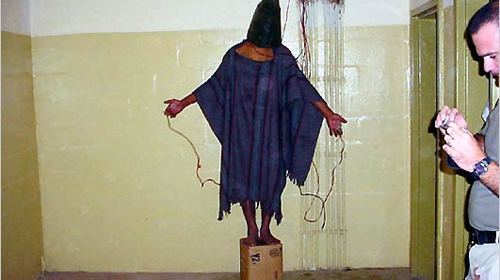The Obama Administration's 2 Faces on Releasing Evidence of U.S. Prisoner Abuse


There is too often a gap between the Obama administration's words and deeds when it comes to transparency on national security issues. Take, for example, whether the government should release information about the abuse of prisoners in U.S. custody.
In a decade-old Freedom of Information Act lawsuit the ACLU is still fighting, the administration recently told the court that it can't release some 2,000 photos showing prisoner abuse at Abu Ghraib and other military detention facilities in Iraq and Afghanistan. The reason, the government says, is because the pictures could be inflammatory and lead to attacks against U.S. interests abroad.
But in December, when asked about the possibility of violence in response to the release of the Senate report on the CIA's torture program, White House Press Secretary Josh Earnest had this to say:
[W]e believe so strongly in the value of actually following through on the release of this report, that it says something critically important about our values as a country, and that even though it may pose some risk to the security situation at diplomatic facilities around the globe – we can take prudent steps to protect those facilities, and that it is critically important – again, consistent with the values of this country – for the declassified version of the summary of this report to be released.
The president himself took a similar stand when talking about Sony's decision to pull "The Interview" from theaters in the face of threats:
I think they made a mistake. . . We can't start changing our patterns of behavior any more than we stop going to a football game because there might be the possibility of a terrorist attack, any more than Boston didn't run its marathon this year because of the possibility that somebody might try to cause harm. So let's not get into that way of doing business.
In our FOIA lawsuit, the district court and the 2nd U.S. Circuit Court of Appeals both held, in 2005 and 2008 respectively, that the photos must be released. In 2009, President Obama announced that his administration wouldn't appeal to the Supreme Court, but then Congress enacted a law that carved out an exception to the FOIA. It gave the secretary of defense the authority to withhold abuse photos for three years if he certified that their disclosure would jeopardize national security. Defense Secretary Robert Gates did just that in 2009, and his successor, Leon Panetta, issued a blanket recertification for the entire collection of photographs in 2012.
The ACLU challenged the mass recertification as insufficient, and last August U.S. District Judge Alvin Hellerstein agreed with us, ruling that the defense secretary has to review each photo individually and give a reason for keeping it secret. The government pushed back, arguing that its process was in fact acceptable.
At a hearing last week, Judge Hellerstein told the government that his view had not changed, saying:
The government is not allowing itself to account. I think that's a mistake… [As] a judge of the court and the government, under laws I feel it's the obligation of the secretary of defense to certify each picture in terms of its likelihood or not to endanger American lives and why.
The judge asked the government how it would like to proceed, giving two options: The government could propose ways to comply with the August ruling, or it could say that the defense secretary does not want to certify the photos individually, in which case the judge would rule for the ACLU and the government could appeal. The government's response – coming in a letter to the court Wednesday – was to do neither of those things. Instead, it asked for clarification of what the government must do to comply with the judge's August ruling.
During last week's hearing, the judge warned the government about its use of delay tactics in this case:
[T]he consequence of what the government is doing is a sophisticated ability to obtain a very substantial delay. . . You appeal. By the time you get to the appeal, maybe two years go by – the issue is not easy – it may be longer. The downside for you is that you can always produce and disclose. And realistically, postponing the day of reckoning of something that is considered to be sensitive is itself a victory, because it postpones an unpleasant decision to a succeeding generation.
And yet now we have another delay tactic from the government (we made this point in a letter to the court today). The American public has a right to know what took place in the U.S. military detention centers, and the photos are essential to that right. Covering them up won't change what happened, and it certainly won't help stop more abuse from happening in the future.
UPDATE: The judge issued his order a few days later, giving specific instructions and setting a deadline of March 17 for the government to follow them or lose the case and have to appeal.
Learn more about torture and other civil liberty issues: Sign up for breaking news alerts, follow us on Twitter, and like us on Facebook.



